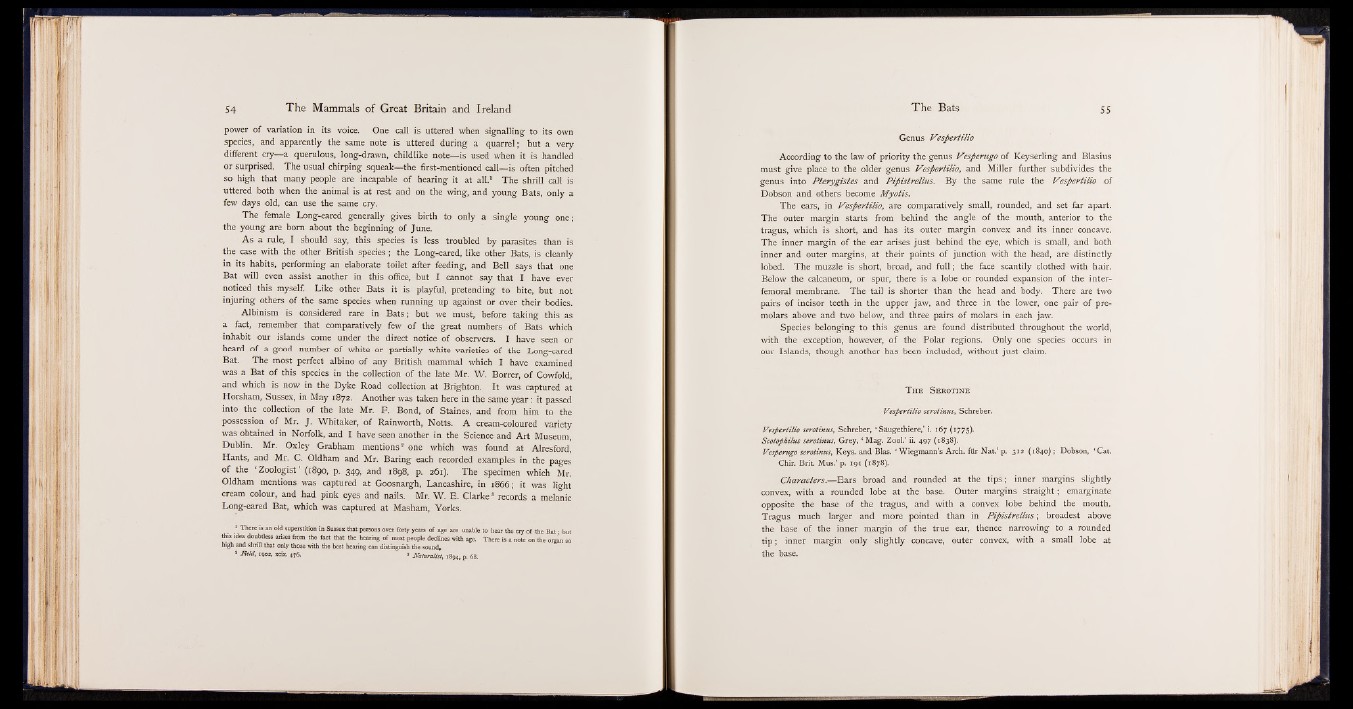
power of variation in its voice. One call is uttered when signalling to its own
species, and apparently the same note is uttered during a quarrel; but a very
different cry— a querulous, long-drawn, childlike note— is used when it is handled
or surprised. The usual chirping squeak— the first-mentioned call— is often pitched
so high that many people are incapable of hearing it at all.1 The shrill call is
uttered both when the animal is at rest and on the wing, and young Bats, only a
few days old, can use the same cry.
The female Long-eared generally gives birth to only a single young one;
the young are bom about the beginning of June.
As a rule, I should say, this species is less troubled by parasites than is
the case with the other British species; the Long-eared, like other Bats, is cleanly
in its habits, performing an elaborate toilet after feeding, and Bell says that one
Bat will even assist another in this office, but I cannot say that I have ever
noticed this myself. Like other Bats it is playful, pretending to bite, but not
injuring others of the same species when running up against or over their bodies.
Albinism is considered rare in Bats; but we must, before taking this as
a fact, remember that comparatively few of the great numbers of Bats which
inhabit our islands come under the direct notice of observers. I have seen or
heard of a good number of white or partially white varieties of the Long-eared
Bat. The most perfect albino of any British mammal which I have examined
was a Bat of this species in the collection of the late Mr. W. Borrer, of Cowfold,
and which is now in the Dyke Road collection at Brighton. It was captured at
Horsham, Sussex, in May 1872. Another was taken here in the same year: it passed
into the collection of the late Mr. F. Bond, of Staines, and from him to the
possession of Mr. J. Whitaker, of Rainworth, Notts. A cream-coloured variety
was obtained in Norfolk, and I have seen another in the Science and Art Museum,
Dublin. Mr. Oxley Grabham mentions2 one which was found at Alresford,
Hants, and Mr. C. Oldham and Mr. Baring each recorded examples in the pages
of the ‘ Zoologist’ (1890, p. 349, and 1898, p. 261). The specimen which Mr.
Oldham mentions was captured at Goosnargh, Lancashire, in 1866; it was light
cream colour, and had pink eyes and nails. Mr. W. E. Clarke8 records a melanic
Long-eared Bat, which was captured at Masham, Yorks.
1 There is an old superstition in Sussex that persons over forty years of age are unable to hear the cry of the Bat; but
this idea doubtless arises from the fact that the hearing of most people declines with age. There is a note on the organ so
high and shrill that only those with the best hearing can distinguish the sounds
a Field, 1902, xdx. 476. 3 Naturalist, 1894, p. 68.
Genus Vespertilio
According to the law of priority the genus Vesperugo of Keyserling and Blasius
must give place to the older genus Vespertilio, and Miller further subdivides the
genus into Pterygistes and Pipistrellus. By the same rule the Vespertilio of
Dobson and others become Myotis.
The ears, in Vespertilio, are comparatively small, rounded, and set far apart.
The outer margin starts from behind the angle of the mouth, anterior to the
tragus, which is short, and has its outer margin convex and its inner concave.
The inner margin of the ear arises just behind the eye, which is small, and both
inner and outer margins, at their points of junction with the head, are distinctly
lobed. The muzzle is short, broad, and full; the face scantily clothed with hair.
Below the calcaneum, or spur, there is a lobe or rounded expansion of the inter-
femoral meriibrane. The tail is shorter than the head and body. There are two
pairs of incisor teeth in the upper jaw, and three in the lower, one pair of premolars
above and two below, and three pairs of molars in each jaw.
Species belonging to this genus are found distributed throughout the world,
with the exception, however, of the Polar regions. Only one species occurs in
our Islands, though another has been included, without just claim.
T h e S e r o t in e
Vespertilio serotinus, Schreber.
Vespertilio serotinus, Schreber, ‘ Saugethiere,’ i. 167 (1775).
Scotophilus serotinus, Grey, ‘ Mag. Zool.’ ii. 497 (1838).
Vesperugo serotinus. Keys, and Bias. * Wiegmann’s Arch, fur Nat.’ p. 312 (1840) ; Dobson, ‘ Cat.
Chir. B r it Mus.’ p. 191 (1878).?
Characters.— Ears broad and rounded at the tips'; inner margins slightly
convex, with a rounded lobe at the base. Outer margins straight; emarginate
opposite the base of the tragus, and with a convex lobe behind the mouth.
Tragus much larger and more pointed than in Pipistrellus; broadest above
the base of the inner margin of the true ear, thence narrowing to a rounded
tip ; inner margin only slightly concave, outer convex, with a small lobe at
the base.